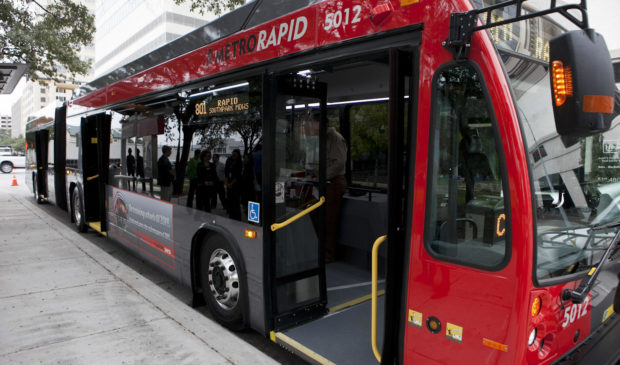Connections 2025 experiencing a month delay due to rider concerns
Thursday, November 17, 2016 by
Caleb Pritchard The Capital Metropolitan Transportation Authority is moving a little less rapidly toward the adoption of Connections 2025, thanks in part to public outcry about some of its proposed service changes.
The agency is banking that the long-range service plan and its emphasis on frequent service will reverse sliding ridership, which the agency’s board of directors learned on Wednesday has fallen again for the third year in a row.
At the same Wednesday meeting, Connections 2025 project manager Lawrence Deeter told board members that they will vote on the final recommendation in January, one month later than planned.
“At this point, I can tell you that I believe it is unlikely that most of the recommendations would be implemented earlier than August 2017, and likely not until 2018,” Deeter said.
The announcement came at a meeting packed with riders upset over the potential loss or significant alteration of a handful of routes under Connections 2025.
Most prominent was a group of a dozen or so staff and special needs students from the Eanes Independent School District who spoke against the impending change to a route that skirts Austin’s border with West Lake Hills and Rollingwood, two cities that are not taxpaying members of Capital Metro’s service area.
Wearing red shirts that read “#SaveThe30,” several of the students explained that the route’s jog down Bee Cave Road and then Walsh Tarlton Lane toward Barton Creek Square and ultimately to the South Congress Transit Center helps connect them from home to the school district’s Adult Transition Services, a special education program for high school graduates. Under the draft Connections 2025 recommendations, the entire route would be shortened to connect downtown to Barton Creek Square via the MoPac Expressway.
“I want you to think with your heart,” Eanes ISD board of trustees President Colleen Jones urged the Capital Metro board. “I want you to think about the coverage.”
That plea for the No. 30 was joined by other riders as well as West Lake Hills Mayor Linda Anthony. Board Chairman Wade Cooper suggested mirthfully to Anthony that the agency would be happy to have her city contribute part of its sales tax revenue in order to join the service area. Cooper demurred, citing her city’s winding street configuration and lack of dense housing.
Other speakers challenged the Connections 2025 proposals to remove the Nos. 21 and 22 from Exposition Boulevard in Tarrytown, and the replacement of the No. 100 Airport Flyer with the proposed No. 820 MetroRapid line that would run through downtown on Guadalupe and Lavaca streets, thus bypassing the urban core’s concentration of hotels.
After the public testimony, City Council Member Delia Garza, who is also on Capital Metro’s board, reassured the speakers as they filed out.
She told them, “There have been members of this board who are very concerned about these proposed changes. I want the public to know that none of this is final.”
Capital Metro staff have been engaged in an intensive public outreach process since rolling out the Connections 2025 draft proposal. The entire process itself kicked off earlier this year with stakeholder meetings and surveys, and planners say the results revealed that residents want to see a network with an increased focus on frequent service rather than geographic coverage.
On Wednesday, Deeter told the board that the proposed route adjustments, including the changes to the No. 30, were based in part on low ridership due to areas with land-use not amenable to bus transit.
“These are areas where the service is currently well below our performance measures of an average subsidy per passenger of $4 per trip, or an average 26 customers per hour,” he explained.
However, Deeter pledged that his team would “continue to investigate these areas” and bring a definitive final set of recommendations in December, which the board would then vote on in January. Even then, the changes would have to pass through the agency’s regular service change process, which involves even more public input.
For current riders who find themselves without a ride due to the sacrifice of coverage to frequency, Deeter said the agency is exploring alternatives to conventional bus service.
Cooper suggested that among those alternatives could be the agency’s RideShare option, a vanpool service that represents the segment of the agency’s services that saw the biggest ridership increase in Fiscal Year 2015-2016.
Todd Hemingson, vice president of strategic planning and development, told the board on Wednesday that RideShare saw a 26.1 percent boost in use compared to the year before. However, its 432,537 trips paled in comparison to the 21,801,298 rides taken on fixed-route bus service. That number represented a 2.6 percent year-over-year drop.
Across the board, the agency provided nearly 30.5 million rides in FY 2015-16, down from more than 34 million in FY 2012-13.
The Austin Monitor’s work is made possible by donations from the community. Though our reporting covers donors from time to time, we are careful to keep business and editorial efforts separate while maintaining transparency. A complete list of donors is available here, and our code of ethics is explained here.
You're a community leader
And we’re honored you look to us for serious, in-depth news. You know a strong community needs local and dedicated watchdog reporting. We’re here for you and that won’t change. Now will you take the powerful next step and support our nonprofit news organization?









